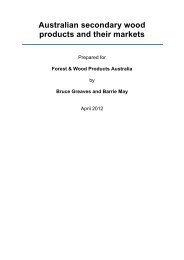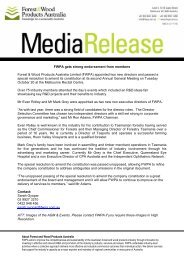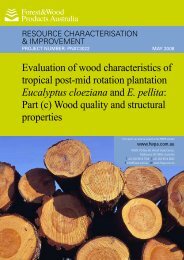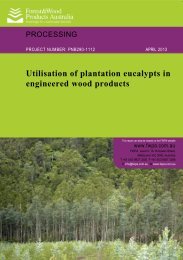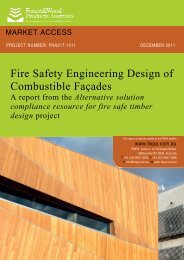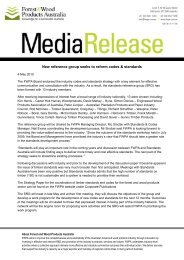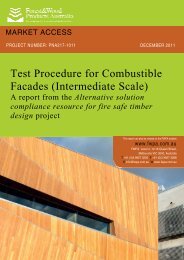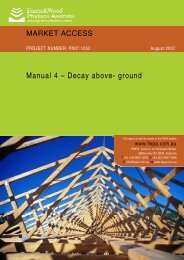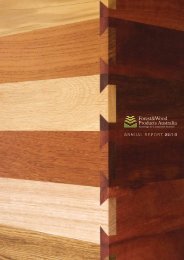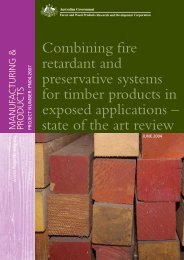Predicting the water-use of Eucalyptus nitens plantations in ...
Predicting the water-use of Eucalyptus nitens plantations in ...
Predicting the water-use of Eucalyptus nitens plantations in ...
Create successful ePaper yourself
Turn your PDF publications into a flip-book with our unique Google optimized e-Paper software.
Stemflow (L)<br />
500<br />
450<br />
400<br />
350<br />
300<br />
250<br />
Figure 10. Relationship between stem diameter and stem flow for 4 trees at Forestier<br />
Canopy <strong>in</strong>terception was <strong>the</strong>n calculated to account for 182 mm <strong>of</strong> <strong>the</strong> ra<strong>in</strong>fall occurr<strong>in</strong>g at<br />
<strong>the</strong> site:<br />
Canopy <strong>in</strong>terception = Ra<strong>in</strong>fall – Throughfall – Stemflow = 854 – 632 – 40 = 182 mm/yr.<br />
3.7. Transpiration<br />
Transpiration is <strong>the</strong> product <strong>of</strong> sapwood area and sap velocity. Plot sapwood area, plot sap<br />
velocity and plot transpiration were calculated for each day, and transpiration was summed<br />
for <strong>the</strong> period <strong>of</strong> <strong>the</strong> study.<br />
Plot sapwood area was estimated for each day by assum<strong>in</strong>g l<strong>in</strong>ear growth <strong>in</strong> sapwood<br />
between <strong>the</strong> sapwood estimates derived from plot <strong>in</strong>ventory.<br />
Sap velocity was measured at 4 locations <strong>in</strong> each <strong>of</strong> 4 trees from 24/2/2011 to 7/2/2012.<br />
Sensors were allocated to different depths below <strong>the</strong> cambium to generate sap velocity<br />
estimates that were representative <strong>of</strong> <strong>the</strong> range <strong>of</strong> flow rates observed <strong>in</strong> <strong>the</strong> sapwood band.<br />
Sap velocity was estimated for each day by tak<strong>in</strong>g <strong>the</strong> average value <strong>of</strong> all operat<strong>in</strong>g sensors<br />
for that day. There were very few days with no data. Data from 1/11/11 onwards were<br />
modified to account for <strong>the</strong> large step change <strong>in</strong> sap velocity that occurred when sensors were<br />
moved to new positions on this date – it appears that <strong>the</strong> pott<strong>in</strong>g mix that <strong>in</strong>sulates <strong>the</strong><br />
<strong>the</strong>rmistors <strong>in</strong> <strong>the</strong> sensors had degraded and that mov<strong>in</strong>g <strong>the</strong> probes ca<strong>use</strong>d <strong>the</strong> pott<strong>in</strong>g mix to<br />
fracture lead<strong>in</strong>g to <strong>the</strong> erratic behaviour seen <strong>in</strong> some probes from this time onwards. Figure<br />
11 shows <strong>the</strong> daily average sap velocity values after <strong>the</strong> last months <strong>of</strong> data were modified.<br />
17<br />
y = 18.2x + 43.9<br />
R² = 0.99<br />
200<br />
10 12 14 16 18<br />
Stem diameter (cm)<br />
20 22 24 26



